The Checker Maven
The World's Most Widely Read Checkers and Draughts Publication
Bob Newell, Editor-in-Chief
Published every Saturday morning in Honolulu, Hawai`i
Noticing missing images? An explanation is here.
A Study In Structure

In this month's excerpt from Willie Ryan's unmatchable Tricks Traps & Shots of the Checkerboard, we see a situation that Willie characterizes as "not so impressive as most of the other items." Of course, Willie has extremely high standards, but we can certainly say that we're impressed with this little gem! Add in the fact that it is of practical use, and you have something that certainly ought to command our attention. Here's Willie to explain it all to us.
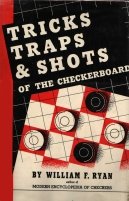
"The following stroke theme is not so impressive as most of the other items in my compendium, but it is one of major importance, and of a type most likely to be overlooked in crossboard play. The game itself was adapted from one I played with 15-year-old Leonard Rosenfield, of Boston, who has all the promise of a future World Champion.
| 9-13 | 15-18 | 6-15 |
| 24-20 | 28-24 | 32-28 |
| 6- 9 | 11-15 | 12-16---A |
| 22-18 | 26-23 | 30-26 |
| 10-15 | 8-11 | 16-19---C, |
| 18-14 | 23-19 | forming the |
| 9-18 | 2- 6 | diagram. |
| 23-14 | 19-10 |
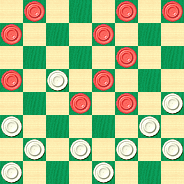
WHITE
White to Play and Win
W:W14,20,21,24,25,26,27,28,29,31:B1,3,4,5,7,11,13,15,18,19.
A---If 4-8 is moved, follow with 30-26* (not 24-19,15-24, 28-19, 11-15, 19-10, 18-22, 25-18, 5-9, shot), 12-16---B, 26-23, 8-12, 25-22*, 18-25, 29-22, 16-19, 23-16, 12-19, 22-18* (not 31-26, 1-6, 14-10, 7-14, 27-23, 14-18*, 23-14, 6-9, 14-10, 9-14, etc., black wins), 15-22, 24-8, 3-12, 27-24, 1-6, 20-16, 12-19, 24-15, 22-25, 28-24, 25-30, 24-19, 30-25, 31-27*, 25-22, 27-24, etc., ending in a draw. Leonard Rosenfield vs. Wm. F. Ryan.
B---18-22, 25-18, 15-22, 26-17, 13-22, 27-23, 11-15, 23-18, 8-11, 24-19, 15-24, 28-19, 1-6, 19-15, 22-26, 31-22, 7-10, 14-7, 3-19, 29-25, etc., accomplishes a draw. Wm. F. Ryan.
C---Down the wrong alley! The correct thrust is 4-8, 26-23, 8-12, making the draw play shown in Note A."
Can you structure a solution, or is your thinking perhaps too rigid? Clicking on Read More is a predictable part of our weekly structure, and you know that it will bring you straight to the solution, and an interesting computer addition to Willie's original analysis.![]()
Small, Square, Two Inches of Ivory

The famous British novelist of the late 18th and early 19th century, Jane Austen, spoke of her writer's canvas as a "small, square, two inches of ivory." By this she seemed to have meant that her works were limited in scope and in some sense "miniatures" based on the society in which she lived.
But this is a checker column, not a literary review, and we bring up Miss Austen only as a point of comparison to miniatures in checkers. They too deliberately limit their scope, but, like Jane Austen's famed novels, have no lack of intricacy, depth, and ultimately, charm.
Today we publish a Checker School study taken from the pages of Ben Boland's Famous Positions in the Game of Checkers. It's indeed a small square of ivory with much appeal and value. Here's the position.
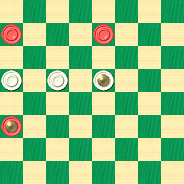
WHITE
White to Play and Draw
W:W13,14,K15:B5,7,K21.
Can you find the White draw in this deceptively simple setting? You needn't be a Victorian gentleman or lady to find the answer; pure skill at checkers is what's required. When you've arrived at your solution, click Read More for the correct procedure accompanied not by harpischord or pianoforte, but instead a trio of sample games and extensive explanatory notes.![]()
Uncle Ben's Porch: Tommy's Tryout

It was getting near the end of the school year. Tommy had done well and had kept up his grades, and so Mom had allowed him to continue to spend a couple of hours every Saturday morning over on Uncle Ben's porch, learning checker lore from the old retired gentleman, who had won much-justified fame and recognition in an earlier year as a checker author, teacher, and master player.

"Well, Tommy," Uncle Ben said as they had settled into their chairs on another hot and steamy Florida morning, "pretty soon there will be the Elementary School Varsity Checker Team tryouts."
"Yes, Uncle Ben," Tommy replied, "I'm eligible for the team next year, and the tryouts take place just before the end of this year." (Of course, Uncle Ben wasn't really Tommy's uncle, but everyone called him that.) "I'm going to do my best to make the team," Tommy added.
"Well, Tommy, you've been coming right along," Uncle Ben said, "but of course your school has one of the top teams and it's going to be tough competition to win a team spot." Uncle Ben paused and reflected for a moment. "Now I know you're probably the best player in your class, but it's quite rare for someone to make Varsity the very first year that they're eligible. So it just might happen that you would have to play Junior Varsity for a season or two."
Tommy knew that Uncle Ben was trying, in his own kind and gentle way, to tell him not to be disappointed if he didn't make the team on his first try. Tommy understood just how hard that might be. But didn't Uncle Ben know just how badly Tommy wanted to make the team? After all, he'd been working on his checkers really hard this past year, paying close attention to everything that Uncle Ben taught him each Saturday morning. And besides, he'd made a point of keeping up his grades, skipping all of his favorite weeknight television programs in order to have enough time to do really good schoolwork.
Uncle Ben winked at Tommy, He did that often, but it still always caught Tommy by surprise. Uncle Ben always seemed to know just when to lighten the mood, offer a glass of his delicious homemade lemonade, or just the right word of encouragement. He really was a special kind of grownup.
"Oh yes, Tommy, I do know what you're thinking, and you have indeed turned into a fine young checkerist. But some things just take time. The wood in these fine old chairs we're sitting on didn't get seasoned over night. Some things just take time and waiting and patience. That's often hard for a young fellow to understand, but you'll see it all in time. So do your best, and whether you make the Varsity team now or a little later, I'll still be very proud of you and all that you've learned."

Before you could know it, the lemonade glasses were filled to the brim, and Uncle Ben had turned to the checkerboard, which as usual was set up with the day's work. "So, Tommy, I've got one for you here," Uncle Ben said. "It's something that will come up often in your games and who knows, you might even see it in your tryouts. Take a look."

Well, Tommy thought, Uncle Ben is hardly ever wrong--- he couldn't remember a single time, in fact, that Uncle Ben hadn't taught just the right thing at just the right time. Tommy sipped the cool, refreshing lemonade while he looked over the position Uncle Ben had laid out.
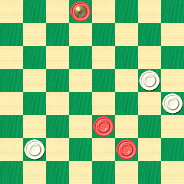
BLACK
Black to Play and Win
B:W17,13,8:BK31,10,6.
As usual, it didn't look easy at all, but Tommy knew that Uncle Ben was always giving him something that would stretch and grow his skills while still staying within his grasp... if he would just work at it hard enough. This time, Tommy was through most of his glass of lemonade before the idea came to him, and as he always did, said, "Hey Uncle Ben, how about this...." and started to move the pieces.
Can you solve the position? Whether or not you played Varsity Checkers for your school, give it a try and then click on Read More for the solution, a sample game, and no less than twenty additional examples of this theme.![]()
Computer-Aided Checker Instruction

Editor's Note, January 2025: The software discussed here is no longer available and has not been for many years. The website is off the air as well.
In the world of chess, computer aids to learning are ubiquitous; virtually every chess vendor offers a bewilderingly extensive line of products, from problem collections to video tutorials to opening book trainers. Numerous other board games offer at least a few products to help build your expertise or perfect your skills. But in the world of checkers, you'd be hard pressed to find anything even remotely similar to the wide variety of choices available for other games.
However, there is an option, and checkerist Al Lyman has been working on it and refining it for a number of years. In its latest form, it's called Straight Checkers Gold and can be found at Al's Checkerworld site. Combining the original "Straight Checkers" program with two "mini" tutorial programs, the package currently sells for $59. A supplement called Formations is available for an additional $39.
Our purpose today isn't to promote Al's packages, or even to do a complete review; instead, we'd like to showcase a sample problem from each of his offerings and let you see for yourself. To our knowledge, there are no other even slightly serious computer-based checker training programs available anywhere else in the world, so in that respect, the Straight Checkers series is unique indeed.
Straight Checkers Gold consists of numerous modules and lessons, as shown in the screenshot below (click on the picture for a full-size version).
The modules and lessons can be studied in any order; there is no particular sequence or syllabus. Here is an example taken from the "sight solver" section, a grouping of 18 moderately easy problems.
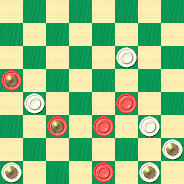
BLACK
Black to Play and Win
B:W22,16,9,K5,K4,K1:BK20,14,K11,10,2.
The additional Formations package proposes additional lessons about common checker patterns and formations, but quite a bit more is provided. Again, you can click on the screenshot below for a full-size version.
Here's an example position demonstrated in the tutorial, from the Wilderness run-up:
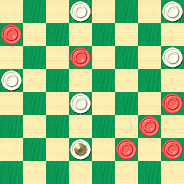
BLACK
Black to Play and Draw
B:W31,29,21,20,15,K7:B28,23,13,9,6,5.
As we said, we're not attempting a review of Al's packages. A demo version is available on Al's website, and you're best advised to take a look and see what you think. We can say, however, that there is truly nothing else like these programs to be found anywhere!
Click on Read More for the solutions to the problems above.![]()
Reed's Rattler

While the rattler similar to the one shown above can often be seen in the countryside near our Santa Fe offices, in this month's chapter of Willie Ryan's Tricks Traps & Shots of the Checkerboard, we're talking about a different kind of rattler; namely, a position that leaves you feeling, well, rattled. And, in Willie's example, who better to be the "rattlee" than that checker pedantic of yore, Harvey L. Hopkins, who, based on his writing, certainly seemed to be more than a little on the stodgy side. We can just imagine him becoming rattled indeed in the very odd position which arises below. Of course, Willie's remarks on "Chop Suey Checkers" and "Chinese checker games" might not pass muster in today's environment of political correctness, but we hope you'll allow the allusions; they're rather colorful and certainly well intended.
And now, here's Willie.

"Old-timers say that Champion James P. Reed was unbeatable when he was sober. His uncanny ability to penetrate the possibilities of play in complicated situations won him the distinction of being the greatest crossboard player of his day. Reed's main dish was 'Chop Suey Checkers,' a term he used to describe positions in which the pieces became entangled in complete confusion. The game below shows what happened to Harvey L. Hopkins, of Chicago, when Reed caught him in one of his Chinese checker games many years ago."
| 11-16 | 18-15 | 10-14 |
| 24-20 | 5-9 | 27-24 |
| 16-19 | 25-22 | 18-23 |
| 23-16 | 9-14 | 22-18---B |
| 12-19 | 29-25 | See the |
| 22-18 | 14-18 | diagram. |
| 9-13---A | 20-16 |
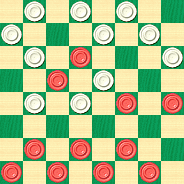
BLACK
Black to Play and Win
B:W32,31,30,28,26,25,24,21,18,16,15:B23,19,14,13,8,7,6,4,3,2,1.
A---This enigmatic move was a great favorite with Mr. Reed, and one which led opponents into a maze of complicated formations so dense that even seasoned masters often became hopelessly lost in their kaleidoscopic patterns.
B---It should be noted that 31-27 also loses here, by 6-9, 27-18,14-23,15-10 (forced), 7-14, 24-15, 23-27, 32-23, 8-11,15-8,4-20, 22-18,1-5, etc., and black wins. Wm. F. Ryan. White's best move at B is 24-20, then 7-10*---C, 16-12---D, 14-18, 21-17, 2-7, 28-24, 19-28, 26-19, 18-23, 25-21 (31-27, 23-26, 30-23, 7-11, 20-16*, 11-20,*, 23-18*, 8-11, etc., a draw), 8-11, 15-8, 4-11, 15-8, 4-11, 19-16, 11-15, 16-11, 7-16, 20-11, 15-18, 22-15, 13-22, 31-27, 10-19, 27-18, 19-23, leading to a draw. Wm. F. Ryan.
C---If 14-18 is used, white will win with 16-11*, 7-16, 20-11, 6-10 (forced; if 1-5, then 31-27, 19-24, 27-20), 15-6, 8-15, 21-17*, 1-10, 17-14, 10-17, 28-24, 19-28, 26-10, 17-26, 30-14, 13-17, 25-22, 18-25, 29-22, 4-8, 14-9. Wm. F. Ryan.
D---If 22-18 is used, then the following moves will produce a draw: 1-5, 18-9, 5-14, 31-27, 14-18, 16-12, 2-7 (8-11 draws too), 15-11, 7-16, 20-11, 8-15, 25-22, 18-25, 27-11, 10-15, 32-27, 6-10, 11-7, 13-17, 21-14, 10-17, 30-14, 3-17, 27-23, 17-22. Wm. F. Ryan. Again at D, if 16-11 is used, black will win with 14-18, 21-17, 1-5*, 20-16, 8-12, 31-27, 3-8, 27-24, 5-9, 24-20, 9-14."
Can you make your way through this one without getting rattled yourself? No need to hiss; just click on Read More to slither over to the solution.![]()
Andy's Annihilator

In our latest installment from Willie Ryan's Tricks Traps and Shots of the Checkerboard, we present what has to be the most stunning and spectacular position thus far--- and that's saying a lot. Without further ado we'll let Willie tell us about it.

"World's Champion Andrew Anderson is generally conceded to be the discoverer and early coach of James Wyllie, although there is no evidence on the records to indicate that the 'Herd Laddie' ever acknowledged Anderson as his teacher. The great Anderson played five torrid matches with Wyllie between 1837 and 1847, winning four of them, losing one. This may explain why the caustic Wyllie was reluctant to bestow any credit upon his master. A refined and quiet-mannered gentleman, Anderson was versatile as a player and as an analyst. It has been said that none of the trunk games in his Guide has ever been corrected. Among Anderson's best known analytical sparklers is this instructive sortie on the Souter opening. Proceed with:
| 9-14 | 23-19 | 11-16 |
| 22-17 | 6- 9 | 17-14 |
| 11-15 | 17-13 | 16-23* |
| 25-22 | 2- 6 | 31-26---F |
| 8-11 | 22-17 | 10-17 |
| 29-25 | 14-18 | 21-14, |
| 4-8---A | 26-22---E | arriving at |
| the diagram. |
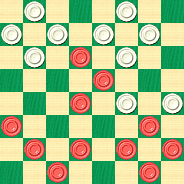
BLACK
Black to Play and Win
B:W32,30,28,27,26,25,24,22,14,13:B23,18,15,12,9,8,7,6,5,3,1.
A---In a match game between Robertson and Wyllie, the former used 11-16 at this point, and the following sensational play ensued:
| 11-16 | 27-23 | 11-15 | 31-27 | 11-27 | 26-23 |
| 24-20 | 19-24 | 19-16 | 5-9 | 19-15 | 19-26 |
| 16-19 | 28-19 | 7-11 | 27-24 | 10-19 | 30-7---D, |
| 23-16 | 15-24 | 16-7 | 15-18 | 17-10 | resulting |
| 12-19 | 32-28 | 2-11 | 23-19 | 6-15 | in a draw. |
| 17-13---B | 8-11 | 22-17 | 8-12---C | 13- 6 | |
| 4-8 | 28-19 | 3-8 | 20-16 | 1-10 |
B---White dare not attack the piece 27-23, as 5-9, 23-16, 9-13, in reply, ends all organized resistance, and black wins.
C---At this move, one of Wyllie's cronies, Peter Rule, entered the playing room, and after hastily taking inventory of the situation on the board, exclaimed, 'My, Mr. Wyllie, how did you ever get into such a scrape as this?'
'I am a piece ahead,' was the pert reply. Then Wyllie moved 20-16, proceeded to give away six men as fast as Robertson could take them, and acquired a draw amidst loud salutes of general admiration.
D---A splendidly played crossboard game, which is worthy of close analytical study by all grades of players.
E---A tricky but untenable move, which requires black to meet it with exacting play. The correct move here is 26-23, as exemplified in Mclndoe's Slingshot (previously published here --Ed.).
F--21-17, at this point, would be crushed by 23-26, 30-23,15-19, 23-16, 12-19, 24-15, 10-19, 22-15, 9-18, 31-26, 7-10, etc., with black winning."
Make no mistake, this one is a real shocker, and a genuine challenge even to a top player. Can you do it? Don't get annihilated; click on Read More to blast your way to the incredible solution.![]()
Second Position

Our ballerina above is showing good form in demonstrating Second Position. We'll wager that ballet's Second Position is known to more of the general public than checker's Second Position--- but we'll bet the margin is small.
We continue with our review of the basics in this month's Checker School column, drawn as usual from the erudite pages of Ben Boland's Famous Positions in the Game of Checkers. And what can be more basic than Second Position? You may ask why we even bother with such an old warhorse, as it's been presented in virtually every basic checker textbook since time immemorial.
If you've mastered this position, we'll accept your argument, and you can browse on over to your favorite alternate checker site. But how many of us have really mastered all the nuances? Today, we take you on the backstage tour of Second Position, and by the time you're done, you'll be able to literally dance your way through this tricky but important ending.
Try your hand at the following progressively more difficult three examples.
W. PAYNE
WHITE
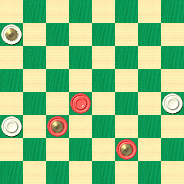
BLACK
Black to Play and Win
B:WK28,13,12:B15,K11,K6.
J. STURGES
WHITE
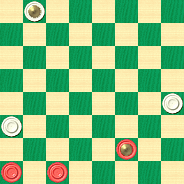
BLACK
Black to Play and Win
B:WK32,13,12:BK6,4,3.
A. ANDERSON
WHITE
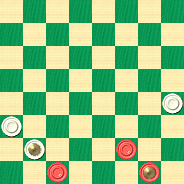
BLACK
Black to Play and Win
B:W13,12,K8:B6,3,K1.
Can you solve them all? Never have a "second" thought about clicking on Read More to see detailed notes, a sample game, and virtually all that you'll ever need to know.![]()
McIndoe's Slingshot

In the right hands (or perhaps we should say in the wrong hands) a slingshot can be quite a fearsome weapon. In this month's installment from Willie Ryan's Tricks Traps and Shots of the Checkerboard, the Bronx Comet shows us how such a weapon can be used over the checkerboard. Willie credits his example to another Brooklyn great. Here's Willie to tell us about it.

"When the tenability of a line of play depends on the execution of a timely shot at the last minute, just when it appears an impasse has been reached, the stroke attains its greatest scientific and artistic value. An unsurpassed example of such a climactic touch is bared in the time-tested gem presented on the next page, by the great Jim Mclndoe of yore, a Brooklyn, New York, boardmaster.
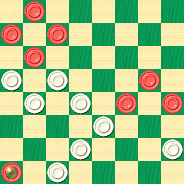
WHITE
White to Play and Draw
W:W13,14,17,18,23,26,28,30:B1,5,6,9,16,19,20,K29.
| 11-15 | 18-22 | 12-16 |
| 23-19 | 25-18 | 27-23 |
| 9-14 | 15-22 | 16-19 |
| 22-17 | 23-18 | 23-16 |
| 6-9 | 11-16 | 7-11 |
| 17-13 | 19-15 | 16-7 |
| 2-6 | 10-19 | 3-19 |
| 25-22 | 24-15 | 32-27 |
| 8-11 | 16-20 | 8-12---A |
| 29-25 | 17-14 | 27-23 |
| 4-8 | 22-25 | 12-16, |
| 22-17 | 21-17 | yielding the |
| 14-18 | 25-29 | diagrammed |
| 26-23 | 31-26 | position. |
A---If 8-11 is moved, a draw results from 18-15, 11-18, 14-10, 6-15, 13-6, 1-10, 27-23, 19-26, 30-7."
Can you solve this one? It's a little harder than some of the others in this series, but you can snap up the solution by clicking on Read More. We're sure you'll agree it's a dandy.![]()
Deans' Position

Um... hold on a minute here. Our column title refers to checkerist E. Deans, not to the famous actor James Dean. One of our editors must have been up late watching old movies, we suppose.
Rather than discussing the movies, though, our Checker School series heads back to some checker basics over the next few months. Today we present a lesson on Deans' Position. It's a classic example of the classic checker principle of mobility. Let's look at the diagram below.
WHITE
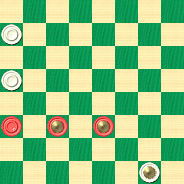
BLACK
Black to Play and Win
B:W28,20,K1:B12,K11,K10.
Black has slightly superior forces with two kings to White's one, but a definite advantage in mobility. The question is, of course, does Black have enough of an advantage to win? In this case, the answer is yes, but showing it is the problem. Can you do it?
Give this textbook position a try and then click on Read More for a detailed solution and several sample games. It's a practical lesson this month and one that you will use often in your own play.![]()
Overlooked by Mail

Roughly once a month, we present an excerpt from Willie Ryan's undisputed classic work of checker tactics, Tricks Traps & Shots of the Checkerboard, and it's proven to be one of our most popular ongoing features. This time Willie turns to the world of postal play with a surprising game. Here's how Willie describes things.

"The similarity of formation and procedure between the preceding example (a Paisley Shocker) and the one ultimately reached in the accompanying game can be identified readily by comparing the two positions at the diagrammed stages. If there is any doubt in the reader's mind that champions are constantly overlooking winning strokes in their play, consider the circumstances in the case at hand. Two of America's foremost mail-game exponents--- Victor Davis, of Fort Dodge, Iowa, and George W. Bass, of Eaton, Colorado--- played this game by mail. When the diagrammed situation was reached, both contestants muffed the killer, the game ending in a draw.
| 10-15 | 27-20 | 1-5 |
| 24-19 | 4-8 | 30-25 |
| 15-24 | 17-13 | 3-8 |
| 28-19 | 2-6 | 22-17 |
| 9-14 | 31-27 | 14-18 |
| 22-18 | 8-11---A | 17-14 |
| 5-9 | 29-25---B | 11-15 |
| 25-22 | 10-15* | 20-16---C |
| 6-10 | 25-22 | 8-12 |
| 22-17 | 15-19 | 21-17---D. |
| 11-15 | 23-16 | See the |
| 18-11 | 12-19 | diagram. |
| 8-24 | 32-28 |

BLACK
Black to Play and Win
B:W28,27,26,25,17,16,14,13:B19,18,15,12,9,7,6,5.
A---Of course, 10-15 loses immediately by the in-and-outer via 21-17, 14-21, 30-25, 21-30, 20-16, 12-19, 23-16, 30-23, 27-2, 8-12, 16-11, 12-16, 29-25, 16-19, 32-27, etc., and white wins. Again at A, if black moves 1-5, white will win with: 23-18, 14-23, 27-18, 8-11, 29-25, 10-15, 26-22, 7-10, 21-17, 12-16, 32-27, 3-8, 30-26, 8-12, 18-14, 9-18, 26-23. Wm. F. Ryan.
B---23-18 would be no good now. For example: 23-18, 14-23, 27-18, 10-14, 26-23, 7-10, 29-25, 10-15, 25-22, 12-16, 32-28, 15-19, 30-26, 3-8, 18-15, 11-27, 20-4, 1-5, etc., and black wins. Wm. F. Ryan.
C---A safer route would be 21-17, 6-10*, 13-6, 19-24, 28-19, 15-31, 26-22, 8-12, 22-15, 10-19; a draw.
D---This is where Bass bogged down in the morass of formation. The move taken allows the thunderbolt that follows; but instead of 21-17, try 16-11*, 7-16, 26-22, 19-23, 14-10, 23-32, 10-1, 9-14, 22-17, for a draw. Wm. F. Ryan."
Don't get buried yourself. After you've tried to solve the position, dig your way out by clicking on Read More to see the solution.![]()
The Checker Maven is produced at editorial offices in Honolulu, Hawai`i, as a completely non-commercial public service from which no income is obtained or sought. Original material is Copyright © 2004-2025 Avi Gobbler Publishing. Other material is public domain, AI generated, as attributed, or licensed under CC1, CC2,CC3 or CC4. Information presented on this site is offered as-is, at no cost, and bears no express or implied warranty as to accuracy or usability. You agree that you use such information entirely at your own risk. No liabilities of any kind under any legal theory whatsoever are accepted. The Checker Maven is dedicated to the memory of Mr. Bob Newell, Sr.



